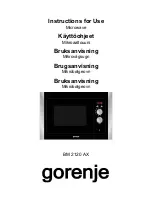
- Eng-6 -
English
Cooking Techniques
Food Characteristics
Timing
A range in heating time is given in each recipe. The time
range compensates for the uncontrollable differences
in food shapes, starting temperature and regional
preferences. Always cook food for the minimum cooking
time given in the recipe and check for doneness. If the
food is under cooked, continue cooking. It is easy to
add time to an under cooked product. Once the food is
overcooked, nothing can be done!
Spacing
Individual foods, such as baked potatoes and
cupcakes will heat more evenly if placed in the oven
equal distance apart. When possible, arrange foods in
a circular pattern.
Similarly, when placing foods around the outside
of accessory, not lined up next to each other. Food
should NOT be stacked on top of each other.
Browning
To shorten the food convection or cooking time and
get good color effect, be sure to apply dark soy sauce
or spicy sauce to the food before baking. For quick
breads or muffins, brown sugar can be used in the
recipe in place of granulated sugar, or the surface can
be sprinkled with dark spices before baking.
Piercing
The skin or membrane on some foods will cause
steam to build up during cooking. These foods must
be pierced or a strip of skin should be peeled off
before cooking to allow the steam to escape. It has a
good performance during convection.
Potatoes — pierced with a fork.
Sausages — scratched smoked sausages. Pierce the
casing with a fork.
Rotating and repositioning food
Sometimes heat cannot be redistributed by stirring
the food. To achieve even cooking effect, you can
reposition or rotate the food. For example, turn over
the food in the cooking process, turn over large
portions of food such as meat or chicken, or rotate the
metal tray during baking.
The cooking method is closely related to the food characteristics.
Size
Small portions cook faster than large ones.
Shape
Uniform sizes heat more evenly. To compensate for
irregular shapes, place thin pieces toward the centre
of the dish and thicker pieces toward the edge of dish.
Starting Temperatures
Room temperature foods take less time to heat up
than refrigerated, or frozen foods.
Density
Porous, airy foods take less time to heat than heavy,
compact foods.
F0003CF00CP_09_EN_20210218.indd 6
2021/2/27 10:33:21








































